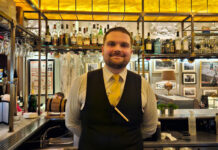Low and no ABV products can offer an alternative, suppliers say
A GLASS of wine with a meal has been a tradition for consumers, and a sales driver for the licensed trade, for decades – but it’s one that is said to be suffering in the wake of the lower drink drive limit.
However, offering a strong range of low or no-alcohol wines could help operators mitigate the impact, say drinks firms.

Graeme Sutherland, sales manager at Enotria Wine Cellars, said: “It is well-documented that since the drink drive limit was lowered last year, rural operators, those that most customers need to drive to, have seen a sharp decline in business, both wet sales for those who still make the effort to come out and actual number of diners visiting establishments.
“Now more than ever, operators need to be looking to lower alcohol and zero alcohol wines.”
Sutherland said some businesses had specifically requested its range of 0.5% ABV wine in the wake of the lower limit.
“There is the added advantage that these wines receive a lower duty rate and as such can be sold at house wine levels as well,” added Sutherland.
The importance of stocking low and no-alcohol products was underlined by Matthew Clark, which has added a number of new products to its range.
The firm’s Iain McPherson said when it comes to low-ABV drinks, taste is “really important”.
“If customers don’t enjoy their first experience of a low/non-alcoholic product there is a chance they will not repeat purchase,” he said.
“In addition, bars need to make consumers aware that low/non-alcoholic products are available; this may take the form of a display, updated drinks lists or through staff training and awareness.
“As the cost of low/non-alcoholic products is lower than their alcoholic equivalents, consumers can still enjoy low/non-alcoholic drinks for less, without the retailer losing margin.”
Kirsty MacKenna of Alliance Wine reckons having a few lower ABV wines on a list is always a good idea.
“For some customers, drinking lower ABV wines may take the worry out of having that glass or two of an evening, when they know they will be driving early the next day,” she said.
Billy Bell, managing director of Wine Importers, which distributes Spanish wine Torres in the UK, said the lower limit is affecting conventional wine sales and advised operators to stock an alternative for those who aren’t drinking alcohol.
He said the Torres Natureo range of alcohol-free wines “has been selling so fast that we have had difficulty keeping up with demand”.
“The big trend is towards alcohol-free wines in every outlet this spring,” he said.
“The new drink driving laws are killing normal house wine sales so smart operators are offering an acceptable alternative.”
Jon Harris, sales director – Scotland at Hallgarten Druitt & Novum Wines, said that not all wines lend themselves to having the alcohol content removed.
“I think offering a lower alcohol alternative is a good idea,” he said.
“Something like a good (not overly sweet) Moscato d’Asti at 5-6% [ABV]; it is much more challenging on the red front as lower/de-alcoholised reds don’t tend to be great.”
Mike Stewart, sales manager at Liberty Wines, agreed, saying his firm does not sell wines which have had the alcohol removed.
“We do not list any de-alcoholised wines as we believe they serve only to commoditise wine and, if anything, encourage excessive consumption,” he said.
“We would only recommend wines where the lower alcohol has been achieved naturally.”
He suggested wines such as Moscato d’Asti from Piemonte, which has an ABV of 5.5%, and some Rieslings from the German Mosel region.
Stewart said low-alcohol wines should be promoted on the wine list alongside their ABVs.
“These can be highlighted by including their alcohol levels on the wine list and promoted as classic styles that use the best grapes at optimum ripeness, giving full-flavoured and delicious wines,” he added.



















